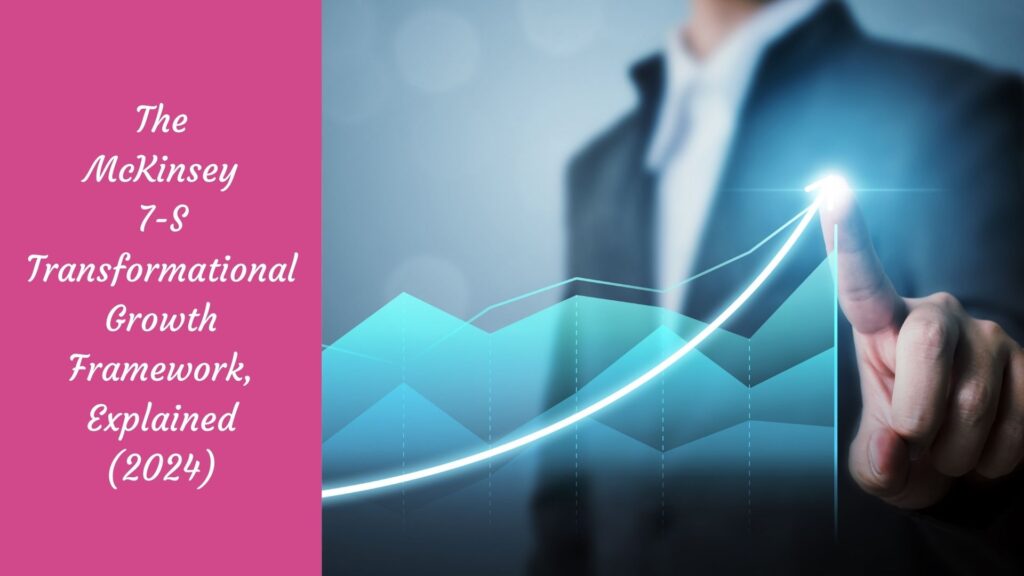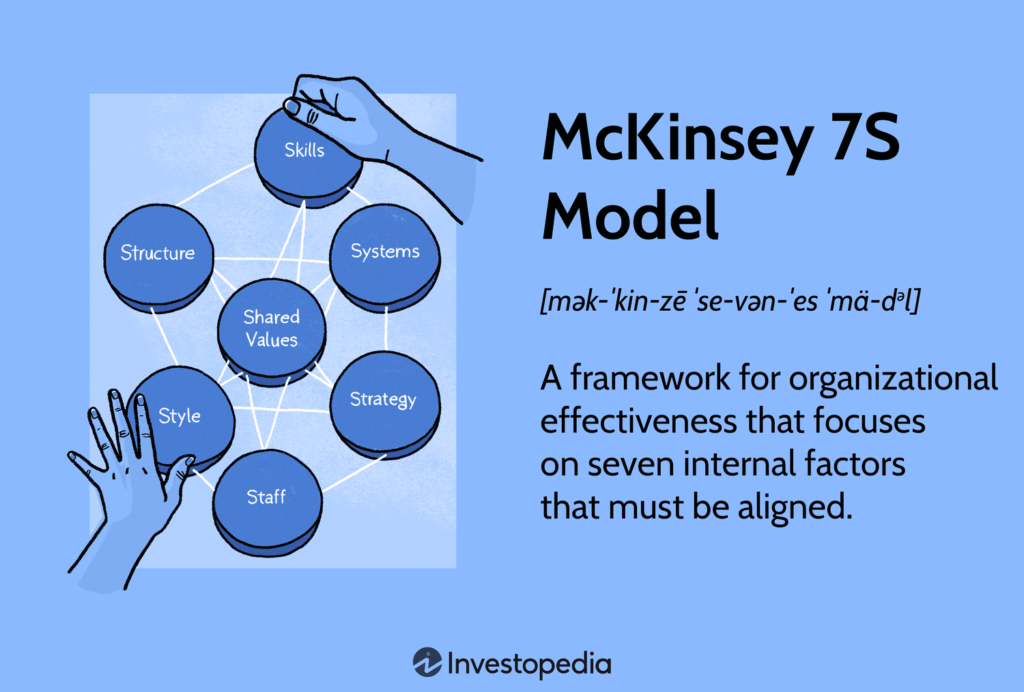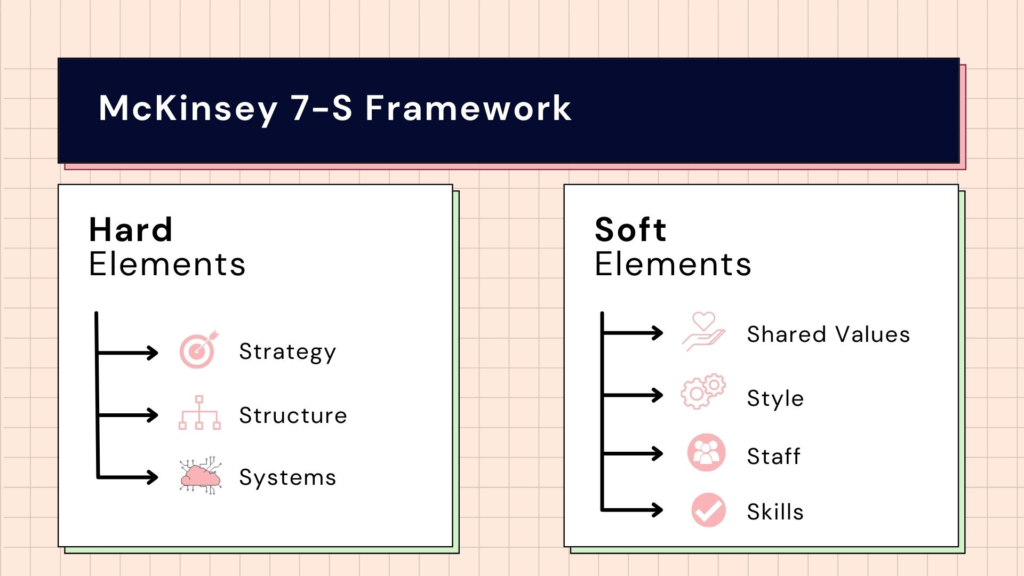In today’s rapidly shifting business landscape, organizations continually face the challenge of remaining competitive while adapting to the ever-evolving market demands. A critical struggle for many companies is achieving cohesive and sustained growth; how can a business align its strategy, structures, and systems to promote enduring success?
The answer lies in embracing the McKinsey 7-S Framework.
Recognizing the intricacies of organizational effectiveness, the McKinsey 7-S Framework presents a holistic approach that examines seven fundamental components: Strategy, Structure, Systems, Shared Values, Skills, Style, and Staff.
By meticulously analyzing and aligning these elements, businesses can foster transformational growth that responds to current industry trends and is resilient enough to withstand future disruptions.
This comprehensive guide will dissect the framework and provide actionable insights into implementing it to achieve strategic harmony and robust organizational growth in 2024 and beyond.
What is the McKinsey 7-S Model, and how do you achieve transformational growth?
The McKinsey 7-S Model, at its core, is a management theory that delineates seven interdependent factors crucial to organizational success. A company can leverage these factors to undergo profound transformational growth when harmonious.
Each element of the 7-S framework underpins a facet of the organization that, when aligned with the others, supports overall strategy execution. Let’s delve into each component with illustrative examples:
- Strategy: This plan is devised to build a competitive advantage and achieve defined business goals. For instance, Netflix’s strategy to pivot from DVD rentals to streaming services has been instrumental in its growth in the rapidly changing media industry.
- Structure: How an organization is arranged, including the hierarchy and divisional makeup. Google’s cross-functional, collaborative team structure helps spur innovation in its many projects and services.
- Systems: The daily activities and procedures staff members use to complete the job. Amazon’s sophisticated logistics and inventory systems ensure a seamless delivery experience for customers worldwide.
- Shared Values: Formerly referred to as “superordinate goals,” these are the company’s core values. Patagonia’s commitment to environmental sustainability permeates its operations, from product design to supply chain management.
- Skills: The capabilities and competencies that exist within the company. Apple’s design expertise spans its product lineup and defines its culture and approach to innovation.
- Style: The leadership approach of top management and the company’s overall operating approach. Satya Nadella’s inclusive and growth mindset-driven leadership style has been credited with revitalizing Microsoft’s culture and business.
- Staff: The company’s employees and their general capabilities. At Zappos, an emphasis on customer service skills has helped maintain its reputation for exceptional customer experiences.
An organization can navigate and initiate significant growth despite industry changes by aligning and regularly reassessing these seven elements. It’s a matter of consistent realignment; as one element changes (for example, a new strategy or system), it necessitates a review and potential adjustment of the others to maintain optimal performance and direction.
The framework isn’t a one-time checklist but rather a dynamic tool that adapts to the company’s evolution, fostering an environment where transformation is not just conceivable but achievable.
The Elements of the McKinsey 7-S Framework
The McKinsey 7-S Framework is designed around seven elements that, when aligned, profoundly impact organizational effectiveness and enable transformational growth:
Strategy:
- Example: Tesla’s focus on sustainable energy has them investing heavily in battery technology and solar energy, which drives their overarching goal of accelerating the world’s transition to sustainable energy.
Structure:
- Example: LinkedIn operates with a flatter organizational structure that encourages open communication and the flow of ideas among team members, thus supporting rapid innovation and responsiveness to user feedback.
Systems:
- Example: Southwest Airlines has streamlined its boarding system with a unique open seating policy and numbered boarding process, which reduces turnaround time for flights and enhances customer satisfaction.
Shared Values:
- Example: Ben & Jerry’s is renowned for its commitment to social causes, like environmental sustainability and social justice, which are deeply embedded into their ethical business practices and decision-making.
Skills:
- Example: The Walt Disney Company’s ability to tell captivating stories is not merely confined to its movies but extends into theme park experiences and cross-platform branding.
Style:
- Example: HubSpot’s leadership promotes a culture of “HEART,” emphasizing humility, empathy, adaptability, remarkable transparency, and tenacity, shaping the company’s interactions internally and externally.
Staff:
- For example, Goldman Sachs invests in top-tier talent skilled in financial services. It fosters a performance-driven culture that rewards commitment and results, maintaining its leading edge in the competitive finance industry.
By converging these elements into a cohesive strategy, each working part of the organization does not just function independently but also complements and reinforces the others.
Correct implementation involves matching the right skills with the right people and aligning them with the company’s structure, style, and shared values, all facilitated by efficient systems that reflect the business’s strategic objectives. When these elements unite, a company is well-equipped to meet the present challenges while steering towards a prosperous future.
Implementing the McKinsey 7-S Model: A Worksheet Template
Organizations can utilize a focused worksheet template to harness the full potential of the McKinsey 7-S Model. This template is designed to deconstruct and analyze each element within the framework, ensuring a comprehensive approach to achieving transformational growth.
Getting Started with Your 7-S Worksheet
Break down your organizational analysis by addressing the following points for each of the seven S elements:
Strategy:
- Define your business’s long-term strategic goals.
- Identify the key initiatives that will drive competitive advantage.
- List the steps needed to implement these strategic initiatives effectively.
Structure:
- Map out your organizational structure, including the leadership hierarchy and departmental organization.
- Analyze how well the current structure supports the strategic goals.
- Consider restructuring to enhance efficiency and alignment with strategy.
Systems:
- List all the systems (financial, HR, operational, etc.) currently in place.
- Assess the efficiency of these systems in current processes.
- Suggest improvements or new systems that could support the strategy more effectively.
Shared Values:
- Identify your company’s core values.
- Evaluate how these values are reflected in your organization’s culture and daily operations.
- Develop an action plan to strengthen or realign these values with your strategic vision.
Skills:
- Inventory the core competencies and skill sets within your organization.
- Determine if skill gaps exist and how they can be filled.
- Plan for skill development and acquisition to meet strategic needs.
Style:
- Describe the leadership style at your company.
- Examine how management’s approach influences company culture and employee morale.
- Propose steps to evolve this style in support of the organizational goals.
Staff:
- Review the workforce in terms of numbers, capabilities, and diversity.
- Identify changes needed in recruitment, development, or retention strategies to align with your business directions.
- Plan for scalable growth in HR capabilities to support long-term strategic goals.
Putting It All Together
After completing the analysis for each component, synthesize the data to identify areas of strong alignment and gaps or inconsistencies that need to be addressed. This full-picture view will guide the strategic execution of transformational changes within the company.
By diligently filling out the McKinsey 7-S Model Worksheet, your organization can make sure every piece of the corporate puzzle is placed thoughtfully, ensuring that each aspect complements the other and collectively propels the company towards its desired future state.
How to Implement McKinsey’s 7-S Transformational Growth Model
Implementing the McKinsey 7-S Model requires a meticulous and systematic approach backed by a solid understanding of the interconnected elements that shape the organization. Here’s a strategy to guide you through the process:
Initiate a Comprehensive Audit
- Conduct a thorough review of the existing organizational framework, comparing it against each ‘S’ element.
- Utilize surveys, interviews, and observations to gather data from various levels within the company.
- Compile findings into a central report to uncover areas of strength and those needing improvement.
Prioritize Areas for Change
- Identify which ‘S’ elements are out of alignment with your strategic vision.
- Prioritize these areas based on their impact on the organization’s overall effectiveness and the speed at which improvements can be made.
Implement Action Plans
- Develop detailed action plans for each ‘S’ that requires adjustment, delineating clear objectives and timelines.
- For example, if ‘Staff’ is a priority, your action plan might include revising the recruitment process to attract high-caliber talent aligned with the company’s strategic goals.
Involve and Communicate
- Engage employees at all levels, communicating the reasons for change and how the model will benefit the organization and them personally.
- Foster an environment that invites feedback and encourages participation in the transformation process.
Monitor Progress and Adapt
- Set up benchmarks and KPIs to regularly measure the effectiveness of the changes.
- Be prepared to revise your strategy, remain flexible, and adapt to new insights as the transformation unfolds.
Solidify Changes in the Culture
- Incorporate the successful changes into policies, routine practices, and the company ethos.
- Share success stories and recognize contributions to reinforce the new direction and shared values.
Review and Improve Continuously
- Assess the 7-S elements as an ongoing process, ensuring sustained alignment with dynamic business environments.
- Continuously look for opportunities to refine and enhance each area, driving perpetual growth and development.
By navigating these steps with the McKinsey 7-S Model as the beacon, an organization can orchestrate transformative growth that is both effective and enduring.
11 Examples of the McKinsey 7s Model in Action
Drawing upon a roster of real-world companies, we can illustrate the application of the McKinsey 7-S Model through vivid examples. Each example underscores how adjustments in one or more of the ‘S’ elements can drive significant organizational change:
Google:
- Structure: Transitioning from a flat to a more conventional corporate hierarchy to support scaling operations.
- Systems: Innovating with Alphabet Inc. to streamline operations and grant autonomy to its various businesses.
Apple Inc.:
- Shared Values: Emphasizing design and innovation are core values permeating every product.
Amazon:
- Strategy: Continuously evolving its business model to include e-commerce, cloud computing, and AI technologies.
Starbucks:
- Staff: Creating employee programs like the College Achievement Plan to build loyalty and align with their community values.
Southwest Airlines:
- Style: Encouraging a leadership approach focusing on employee satisfaction and customer service.
Microsoft:
- Skills: Invest billions in employee training and development to stay ahead in a competitive technology market.
Nike:
- Strategy: Addressing sustainability through strategic initiatives to reduce its carbon footprint across its supply chain.
Coca-Cola:
- Shared Values: Engaging in worldwide brand campaigns that symbolize diversity and unity.
Procter & Gamble:
- Systems: Overhauling its operation systems to prioritize digital marketing and direct-to-consumer sales channels.
Walmart:
- Structure: Restructuring operations to integrate its online and brick-and-mortar retail business more cohesively.
General Electric (GE):
- Strategy: Undergoing a massive strategic pivot to refocus on its industrial roots in energy, aviation, and healthcare sectors, post its financial services divestiture.
Each of these companies demonstrates that when the elements of the McKinsey 7-S Model are thoughtfully analyzed and realigned, significant improvements in performance, culture, and market position can be realized.
Conclusion
The McKinsey 7-S Model is a robust framework guiding organizations through effective transformation in the ever-evolving business landscape.
By emphasizing the interconnectivity of structure, strategy, systems, shared values, style, staff, and skills, it ensures a comprehensive approach to change. Adopting and applying this model can help businesses navigate the complexities of growth and adaptation, leading to sustainable success and a competitive edge.
The synergy among these elements can create enduring excellence and innovation in any organization’s journey toward achieving its strategic goals.







Ive read several just right stuff here Certainly price bookmarking for revisiting I wonder how a lot effort you place to create this kind of great informative website